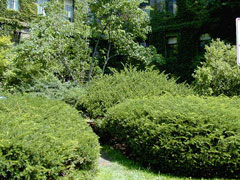


Home
Flowers &
Indoor Plants
Fruits & Nuts
Ornamentals
Vegetables
Special Topics
Resources
Glossary

|
Japanese Yew Taxus cuspidata (tax-us cuss-pid-ah-tah)  Click on thumbnails for larger image. |
 |
What about it? The yew is a narrowleaf evergreen shrub that grows to a height of 8 feet. It is the most widely grown narrowleaf evergreen grown in the northeast United States. Typically, a yew will grow out rather than up. The needles are about an inch long and flat, like a fir. However, the leaves come out of the branches in a spiral arrangement and they have 2 yellowish-green bands on their underside. The fruit of the yew is a small red berry. Both the fruit and the leaves of the yew are poisonous. What is it used for? Yews are handsome plants. They are tolerant of heavy pruning and thus make popular landscape plants. They can be cut and trimmed into almost any size and shape. In addition, they are several different varieties that have been bred to grow in certain shapes and sizes. Since they are quite dense they make excellent hedges and border plants. Because the plant is poisonous you should avoid planting yews where livestock or little children will be tempted by the fruits or the foliage. Where does it grow? How do we grow it?Yews are not too particular about their sites. They will do well in either the sun or the shade. They like moist but well-drained soil. They do not tolerate wet soils however. They should be planted 8 feet apart, 3 feet for hedges. What are its primary problems? The blackvine weevil and the mealybug find the yew quite tasty. 'Wet feet' as mentioned above is also a problem. Yews also are susceptible to injury and foliar burn from late spring frosts.
© Copyright, Department of Horticulture, Cornell University. |